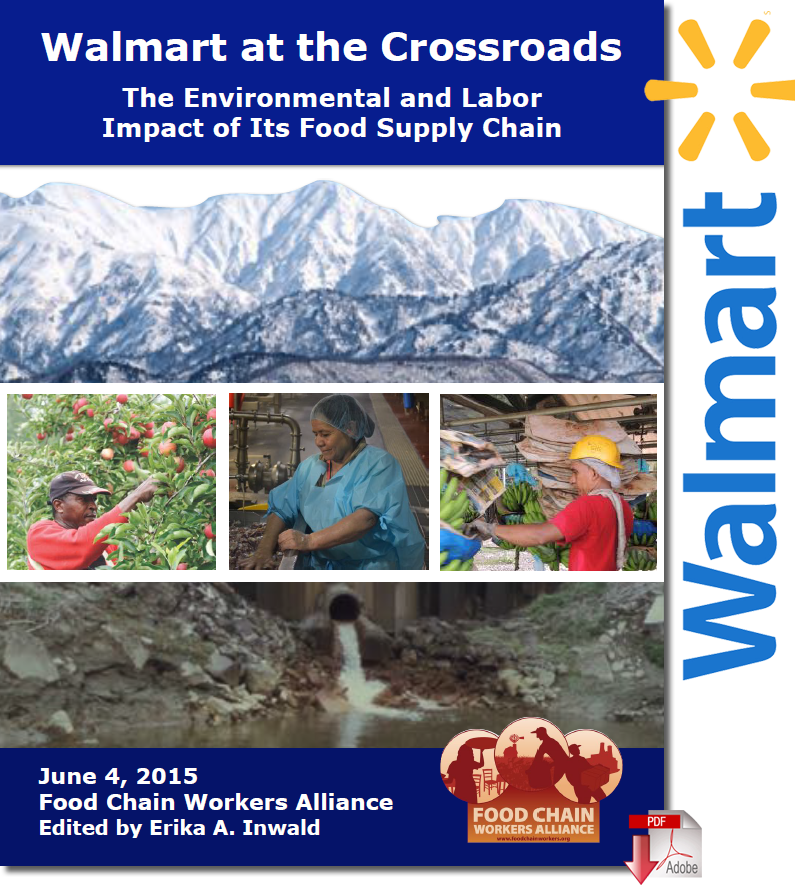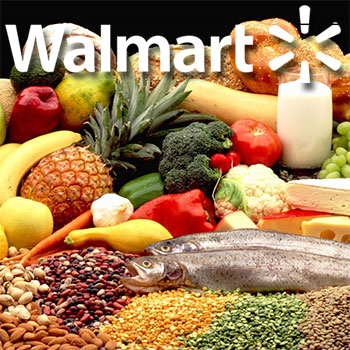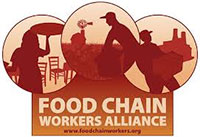New Report Examines Wal-Mart Food Supply Chain

Walmart’s influence on both suppliers and distributors in the food chain gives it incredible power in the global food system and while Walmart and its suppliers have routinely violated its code of ethics, recently the company has demonstrated some willingness to improve its supply chain standards.
Walmart, the world’s largest retailer also accounts for about a quarter of all groceries sold in the U.S.
That gives Wal-Mart Stores Inc. very powerful leverage among its suppliers, and a recent report charges that the company does not do enough to improve conditions for the majority of its food supply chain.
A coalition of organizations called the Food Chain Workers Alliance (FCWA) last week released a report that it claims assesses the “labor conditions of workers in Walmart’s food supply chain as well as the company’s environmental impact worldwide.”
The report also noted:
So far Walmart’s commitments to improving standards appear to be mostly a public relations stunt and haven’t translated to improvements in conditions for most of its food supply chain. Walmart now has an opportunity to wield its power to the benefit of workers, farmers, communities, and the environment.
Wal-Mart has adopted a responsible sourcing code of ethics that should help ensure that its suppliers comply with fair labor standards, environmental regulations, and targets for purchases from small, family farmers. The FWCA contends, however, that the company’s supply chain strategy “leads it to source disproportionately from places with lax local environmental and labor regulations.”
Introduction: Walmart at the Crossroads

With well over 11,000 stores in roughly 27 countries, Walmart is the world’s largest retailer. As stated in the S&P 500 Index, Walmart’s market cap is over $275 billion, which indicates the highest possible category of market capitalization.
These figures mean Walmart is not only at the top of the food-chain of the retail world in brick and mortar stores, it is also one of the most highly valued publicly traded companies in the world. Foodstuffs currently account for some 55% of Walmart sales, which represents roughly 25% of all groceries sold in the United States. Taken together, Walmart’s influence on both suppliers and distributors in the food chain gives it incredible power in the global food system.
While Walmart and its suppliers have routinely violated its code of ethics, recently the company has demonstrated some willingness to improve its supply chain standards and wages for 600,000 of its U.S. employees. So far Walmart’s commitments to improving standards appear to be mostly a public relations stunt and haven’t translated to improvements in conditions for most of its food supply chain. Walmart now has an opportunity to wield its power to the benefit of workers, farmers, communities, and the environment.
Download Walmart at the Crossroads
After detailing a number of reported violations of labor, environmental, and humane treatment of animals, the report offers nine recommendations related to Wal-Mart’s supply chain, including more transparency and a third-party monitor to keep tabs on suppliers, among other things. The report also recommends that Wal-Mart pay all its employees a minimum of $15 an hour, make real investments in renewable energy, and “stop paving fields and forests for new stores.”
Wal-Mart does have a huge impact on its food supply chain and the company’s emphasis on low prices for its customers means that it must pressure its suppliers’ pricing. Should Wal-Mart be concerned about how its suppliers respond to that pressure?
A co-director of the FWCA told The Guardian:
This feels like it’s a real opportunity for Walmart to do the right thing. There’s a drumbeat of different announcements about what they want to do and how they want to be perceived. The question is, is it going to just be a PR stunt, or are they going to actually do something substantive to change the working conditions for millions of people and actually improve the environment?
Wal-Mart stock is the second-worst performer among the Dow 30 stocks so far in 2015, down nearly 14%. The company is trying a variety of new ideas in hopes of pumping up growth, but Wal-Mart’s very size means that little changes don’t make a lot of difference. And expecting the company to give up its historical practice of squeezing suppliers in order to keep its prices to consumers low may be an exercise in futility.
Source: 24/7 Wall Street
Related: Walmart Expands Online Sustainable Shopping

Article Topics
Food Chain Workers Alliance News & Resources
Walmart at the Crossroads New Report Examines Wal-Mart Food Supply ChainLatest in Supply Chain
FedEx Announces Plans to Shut Down Four Facilities How Supply Chains Are Solving Severe Workplace Shortages SAP Unveils New AI-Driven Supply Chain Innovations How Much Extra Will Consumers Pay for Sustainable Packaging? U.S. Manufacturing is Growing but Employment Not Keeping Pace The Two Most Important Factors in Last-Mile Delivery Most Companies Unprepared For Supply Chain Emergency More Supply Chain












